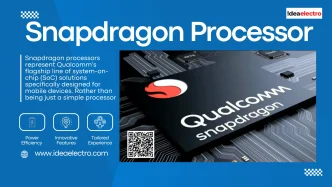Snapdragon processors represent Qualcomm’s flagship line of system-on-chip (SoC) solutions specifically designed for mobile devices. Rather than being just a simple processor, Snapdragon is actually a complete integrated circuit product that combines multiple essential components into a single package. These sophisticated chips are engineered to power embedded systems including smartphones, tablets, laptops, and even vehicles.
Company Background: Qualcomm’s Innovation Legacy
Qualcomm Technologies Inc., the company behind Snapdragon, has established itself as a pioneer in wireless communication and mobile processor technology. The company’s expertise in telecommunications and semiconductor design has positioned Snapdragon as a dominant force in the mobile industry. As of 2014, Qualcomm’s Snapdragon chips were embedded in 41% of smartphones globally, demonstrating the brand’s significant market presence.
Key Components of Snapdragon Processor
Snapdragon processors, developed by Qualcomm, are system-on-chip (SoC) solutions widely used in smartphones, tablets, and other smart devices. These processors are known for their performance, efficiency, and integration of advanced features. Below are the key components that make up a Snapdragon processor:
1. Central Processing Unit (CPU)
The CPU is the core computational unit of the Snapdragon processor, designed to handle general-purpose tasks. Snapdragon CPUs typically use ARM-based architectures, such as the Kryo cores, which are optimized for performance and power efficiency. These cores are often arranged in a big.LITTLE or DynamIQ configuration, combining high-performance cores for demanding tasks (e.g., gaming) and efficiency cores for lighter workloads (e.g., browsing). For example, the Snapdragon 8 Gen series often includes a mix of Cortex-X and Cortex-A cores.
2. Graphics Processing Unit (GPU)
The Adreno GPU, a critical component of Snapdragon processors, handles graphics-intensive tasks such as gaming, video rendering, and user interface animations. Adreno GPUs are known for their high performance and support for advanced graphics APIs like OpenGL, Vulkan, and DirectX. They enable smooth visuals, high frame rates, and support for high-resolution displays, making them ideal for mobile gaming and multimedia applications.
3. Modem
Snapdragon processors integrate advanced modems for cellular and wireless connectivity. The Qualcomm X-series modems (e.g., Snapdragon X75) support 5G, 4G LTE, and earlier standards, providing fast and reliable internet connectivity. These modems also support Wi-Fi (e.g., Wi-Fi 7) and Bluetooth, ensuring seamless wireless communication. The integration of the modem into the SoC reduces power consumption and improves device efficiency.
4. Neural Processing Unit (NPU)
The Hexagon NPU is dedicated to artificial intelligence (AI) and machine learning tasks. It accelerates processes like voice recognition, image processing, and real-time translations. The NPU enables efficient execution of AI-driven features, such as camera enhancements (e.g., night mode, object recognition), voice assistants, and personalized user experiences, while minimizing power usage.
5. Image Signal Processor (ISP)
The Spectra ISP is responsible for camera and image processing. It supports advanced photography and videography features, such as high-resolution image capture, 8K video recording, slow-motion video, and low-light performance. The ISP works with the NPU to enable AI-enhanced imaging, like real-time scene detection and facial recognition, delivering professional-grade camera capabilities.
6. Memory Controller
The memory controller manages the interaction between the processor and the device’s RAM. Snapdragon processors typically support fast LPDDR5 or LPDDR5X memory, enabling quick data access and multitasking. This component ensures smooth performance for memory-intensive applications and contributes to overall system responsiveness.
7. Power Management Unit (PMU)
The PMU optimizes power distribution across the processor’s components, balancing performance and battery life. It dynamically adjusts power allocation based on workload, ensuring energy efficiency during light tasks and maximizing performance during intensive operations. This is crucial for extending battery life in mobile devices.
8. Security Features
Snapdragon processors include dedicated security components, such as the Secure Processing Unit (SPU) and Qualcomm’s Trusted Execution Environment (TEE). These features protect sensitive data, enable secure boot, and support biometric authentication (e.g., fingerprint and facial recognition), ensuring robust device security.
9. Display and Audio Processing
Snapdragon processors include dedicated hardware for display and audio processing. The display engine supports high refresh rates, HDR, and resolutions up to 4K Ultra HD+. The audio subsystem, often powered by Qualcomm’s Aqstic or WCD audio codecs, delivers high-fidelity sound for immersive multimedia experiences.
Snapdragon Series Breakdown
Qualcomm organizes its Snapdragon processor lineup into distinct series, each targeting specific market segments and use cases:
800 Series (Flagship/Premium)
The Snapdragon 800 series represents Qualcomm’s top-tier mobile processors designed for flagship smartphones. These processors feature the most advanced manufacturing processes (typically 7nm, 5nm, or 4nm), highest clock speeds, and most sophisticated AI engines. Recent examples include the Snapdragon 8 Gen 2 and upcoming Snapdragon 8 Elite processors. Target devices include premium smartphones from manufacturers like Samsung, OnePlus, and Xiaomi.
700 Series (Upper Mid-Range)
The 700 series targets upper mid-range devices, offering strong performance with improved power efficiency compared to flagship processors. These chips typically feature advanced manufacturing processes (14nm to 7nm) and robust AI capabilities while maintaining cost-effectiveness. The series provides excellent balance between performance and battery life for consumers who want flagship-like features without premium pricing.
600 Series (Mid-Range)
Snapdragon 600 series processors cater to mainstream mid-range smartphones. These processors offer solid performance for everyday tasks including social media, photography, and light gaming. They typically feature efficient manufacturing processes and balanced CPU configurations optimized for common use cases. The series represents the sweet spot for many consumers seeking reliable performance without premium costs.
400/200 Series (Budget)
The entry-level 400 and 200 series processors focus on affordability while maintaining essential smartphone functionality. These chips typically use older but proven manufacturing processes and simplified architectures. Despite budget constraints, modern iterations still support 4G LTE connectivity and basic AI features, making smartphones accessible to broader market segments.
Comparison Snapdragon with other Processors?
The mobile processor market features several major competitors including MediaTek, Samsung’s Exynos, and Apple’s A-series chips. Each manufacturer brings distinct strengths and approaches to mobile computing.
Snapdragon vs MediaTek: Snapdragon processors generally excel in gaming performance and consistent thermal management, while MediaTek often provides competitive performance at lower price points. MediaTek’s Dimensity series has gained recognition for strong efficiency and 5G integration in mid-range segments. Snapdragon typically maintains advantages in GPU performance through its Adreno graphics processors.
Snapdragon vs Exynos: Samsung’s Exynos processors show strong multitasking capabilities but often lag behind Snapdragon in graphics-intensive applications. Exynos processors typically appear in Samsung devices sold in certain regions, while Snapdragon variants are preferred in others. The Galaxy S25 series represents a significant shift, with Samsung adopting Snapdragon 8 Elite processors globally.
Snapdragon vs Apple A-Series: Apple’s A-series processors generally lead in single-core CPU performance, while Snapdragon excels in integrated connectivity and broader Android ecosystem compatibility. Apple’s tight hardware-software integration often yields superior overall system performance, though Snapdragon offers greater flexibility for diverse device manufacturers.
Snapdragon Performance in Real-World Usage
Gaming Performance and Graphics
Snapdragon processors excel in mobile gaming applications, with the Adreno GPU delivering smooth gameplay across demanding titles. The introduction of hardware ray tracing in recent generations enables console-quality visual effects on mobile devices. Cooperative thermal management between CPU and GPU ensures sustained performance during extended gaming sessions. Advanced features like variable refresh rate support and high-resolution display compatibility enhance the gaming experience.
Power Efficiency and Battery Life
Modern Snapdragon processors achieve impressive power efficiency through advanced manufacturing processes and intelligent power management. The 4nm process used in Snapdragon 8 Gen 2 delivers approximately 20% better battery life compared to previous generations. Dynamic voltage and frequency scaling allows the processor to optimize power consumption based on workload requirements.
AI and Machine Learning Applications
Snapdragon’s AI capabilities have evolved significantly, with recent generations offering substantial performance improvements for on-device machine learning. The integrated AI engine combines CPU, GPU, and Hexagon DSP resources to accelerate various AI workloads including computational photography, voice recognition, and real-time language translation. Performance benchmarks show significant advantages in AI processing compared to competing platforms.
Camera and Multimedia Capabilities
The integrated Spectra Image Signal Processor (ISP) enables advanced camera features including computational photography, multi-camera processing, and 8K video recording. Support for high megapixel sensors (up to 200MP) and advanced video formats ensures compatibility with cutting-edge camera systems. Real-time processing capabilities enable features like portrait mode, night photography, and professional video recording.
Key Advantages of Snapdragon Processors
Android Ecosystem Compatibility and Optimization
Snapdragon processors benefit from deep integration with the Android operating system, ensuring optimal performance and compatibility. Extensive collaboration between Qualcomm and Google results in platform-level optimizations that enhance user experience across diverse applications and use cases.
Regular Software and Security Updates
Qualcomm provides comprehensive software support including regular security updates, driver optimizations, and feature enhancements. The company’s commitment to long-term support ensures that devices remain secure and performant throughout their lifecycle.
OEM Ecosystem and Support
The widespread adoption of Snapdragon processors creates a robust ecosystem of device manufacturers, software developers, and accessory makers. This extensive support network benefits consumers through broader device choices, consistent performance expectations, and comprehensive third-party support.
Potential Limitations and Criticisms
Thermal Management Challenges
Some Snapdragon models have experienced thermal throttling issues under sustained high-performance workloads. However, recent generations have addressed these concerns through improved manufacturing processes, better thermal design, and cooperative CPU-GPU management.
Regional Variations
Certain smartphone manufacturers, particularly Samsung, have historically used different processors in different regions, with Exynos chips appearing in some markets while Snapdragon variants are sold in others. However, trends are shifting toward more unified global adoption, as seen with the Galaxy S25 series using Snapdragon processors worldwide.
Cost Impact on Device Pricing
High-performance Snapdragon processors can contribute significantly to device costs, particularly in flagship segments. However, the comprehensive feature set and performance capabilities often justify the premium for consumers seeking top-tier smartphone experiences.
Notable Phones and Devices Using Snapdragon
Snapdragon processors have powered a wide range of mobile devices over the years—from mid-range budget smartphones to bleeding-edge flagship models. Whether you’re exploring top-tier performance from the Snapdragon 8 Elite series or looking for value in the 7 or 8s Gen 4 chips, here’s a snapshot of distinguished handsets and the exact Snapdragon chips they use.
Snapdragon-Powered Phones
- Samsung Galaxy S25 – Snapdragon 8 Elite (SM8750‑3‑AB)
- Samsung Galaxy S25 Plus – Snapdragon 8 Elite
- Samsung Galaxy S25 Ultra – Snapdragon 8 Elite
- Samsung Galaxy S25 Edge – Snapdragon 8 Elite
- Samsung Galaxy Z Fold 7 – Snapdragon 8 Elite
- Samsung Galaxy Z Flip 7 – Snapdragon 8 Elite
- OnePlus 13 – Snapdragon 8 Elite
- OnePlus 13s – Snapdragon 8 Elite
- Realme GT7 Pro – Snapdragon 8 Elite
- Xiaomi 15 – Snapdragon 8 Elite
- Xiaomi 15 Ultra – Snapdragon 8 Elite
- ASUS ROG Phone 9 Pro – Snapdragon 8 Elite
- Nothing Phone 3 – Snapdragon 8s Gen 4
- Oppo K13 Turbo Pro – Snapdragon 8s Gen 4
- Poco F7 (also listed as Redmi K80 Pro) – Snapdragon 8 Elite (uncertain version, likely same series)
- Vivo V60 5G – Snapdragon 7 Gen 4
- Vivo T4 Pro 5G – Snapdragon 7 Gen 4
How to Identify Snapdragon in a Device
Checking Device Specifications
Consumers can identify Snapdragon processors through several methods including checking device specifications in system settings, manufacturer websites, or retail listings. Most Android devices display processor information in the “About Phone” section of system settings.
Tools for Verification
Third-party applications like CPU-Z provide detailed processor information including model numbers, specifications, and performance characteristics. These tools offer reliable verification for consumers who want to confirm their device’s processor specifications.








